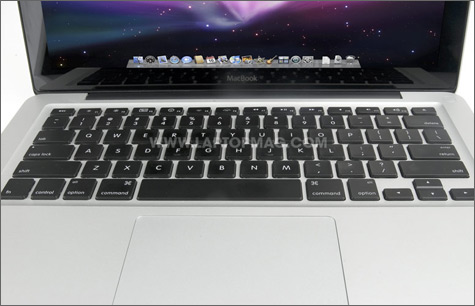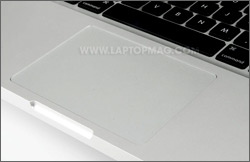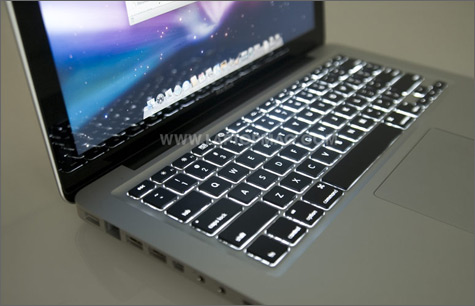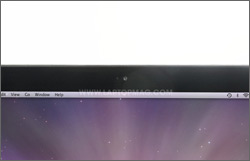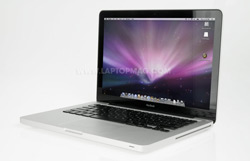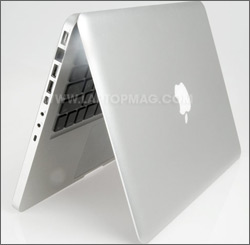Laptop Mag Verdict
A sleek and durable design, strong everyday performance, and good battery life complement Apple's easy-to-use operating system and first-class software bundle.
Pros
- +
Sleek, durable design
- +
Innovative buttonless multi-touch trackpad
- +
Brilliant, edge-to-edge LED-backlit display
- +
Strong graphics performance for the price
- +
Long battery life
Cons
- -
Only two USB ports
- -
Lacks memory card reader and
- -
ExpressCard slot
- -
No mobile broadband option
- -
Display not as rich as MacBook Pro
Why you can trust Laptop Mag
It's not just beautiful. It breaks the mold for thin-and-light notebooks. The new MacBook's unibody aluminum construction, one-of-a-kindtouchpad, and edge-to-edge glass display draw you in, but what impresses us most about Apple's overhaul of its most popular portable is that it offers robust productivity and graphics performance without sacrificing endurance. Yes, you can find comparably configured and attractive Windows systems for less money. But in the case of the newest MacBook(and thenewMacBook Proas well), users get impressive style and speed--and a software bundle that's actually useful and not chock-full of crapware--with very few trade-offs.
A New Look
The newest MacBook borrows some of the design elements introduced with the firstMacBook Air--namely, an aluminum chassis with rounded edges. Like the Air, it has a shallow black keyboard with isolated keys (the last-generation MacBook also had an island keyboard, but its color matched the chassis).
Although the MacBook's aluminum surface looks as smooth as the original Air's, it feels much sturdier. Thanks to a new manufacturing process, the MacBook (and all the other notebooks in the line, save for the entry-level plastic MacBook and the 17-inch Pro, which keeps its old design) is made from one piece of metal, called the unibody, which makes it more resistant to breakage.
Indeed, the MacBook's 12.8 x 8.9 x 1.0-inch chassis felt solid in our hands--not to mention light: At 4.5 pounds it's half a pound lighter than theprevious MacBook(not to mention 0.13 inches thinner). And now, of course, you get the durability that was once reserved for business users.
All Touch, No Buttons
The island keyboard on our $1,599 configuration is backlit in low-light conditions, but this feature is absent from the $1,299 version. It's whisper-quiet and comfortable to type on, but for people used to pillowy keys, it might take some getting used to. Although both the MacBook and MacBook Pro's island keybords are quiet and comfy, the 13-inch MacBook's keys feel a tad shallower in comparison.
Sign up to receive The Snapshot, a free special dispatch from Laptop Mag, in your inbox.
Click to enlarge
The MacBook builds on the last generation's multi-touch touchpad, which allowed users to manipulate on-screen objects as they would on an iPhone: spread your fingers to zoom in on a Web page, or peruse photos with the swipe of a finger. This glass touchpad is 39 percent larger than those of previous MacBooks, and new multi-touch gestures allow users to activate Expos or switch between applications by using four fingers.
Click to enlarge
Aside from its size, the other notable feature of the touchpad is its lack of buttons. Rather, the entire pad doubles as a button. Once you realize that you'll get better results by pressing down on the lower end of the pad, using it feels intuitive.
The touchpad has just the right amount of resistance. Mastering the art of multi-touch took a few minutes, but once we did, it became addictive. Unfortunately, you can still use multi-touch only in Apple applications. For instance, we were able to zoom in on a Safari page by spreading two fingers apart; we could not replicate this in Firefox 3. Mac users have always been able to "right-click" by tapping with two fingers, but now, users can designate the lower right section of the touchpad for right-clicking.
Display and Optical Drive
Another welcome design change is the MacBook Pro's LED-backlit display with a flat, black bezel. The 13.3-inch, 1280 x 800-pixel screen is gorgeous, in no small part because of the seamless, edge-to-edge bezel. The downside is that the bezel picks up fingerprints easily. Moreover, the screen's quality doesn't quite measure up to that of its big brother, the 15-inch Pro.
Click to enlarge
We watched Heroes on DVD side by side on the MacBook and the Pro, and we were pleased with the color and smooth playback in both systems. But the Pro's screen looked less washed out and had richer colors and deeper blacks. As we made the viewing angles more extreme--pushing the screen far forward and watching as close to a 180-degree angle as possible--the differences became more pronounced.
Because the MacBook has a smaller deck than the Pro, its speakers are hidden, instead of flanking the keyboard, as on the Pro. Although the sound wasn't too tinny, it sounded faint compared to the Pro in our side-by-side testing.
Unfortunately, none of the MacBooks have a Blu-ray option, but you can always get your high-def fix from iTunes and other premium video services.
Click to enlarge
Ports and Webcam
The MacBook has two USB 2.0 ports, mini DisplayPort, a MagSafe power port, an Ethernet jack, headphone and mic ports, and a Kensington lock slot. Unlike with the Pro, no FireWire port or ExpressCard slot is included.
Click to enlarge
The MacBook could use more USB ports, as well as an HDMI port. It does not come with an adapter, but Apple sells a mini DisplayPort-DVI adapter for $29. (A mini DisplayPort-HDMI adapter is not available at this time.) The DVI adapter works with monitors as large as 24 inches. If yours is bigger, you'll have to buy the Dual-Link DVI adapter for a hefty $99.
Click to enlargeLike other MacBooks, this one has a VGA iSight camera embedded in the bezel. As with the MacBook Pro, it captured a good amount of detail, such as the shine in our hair. Although our video, too, was bright with lifelike colors, we noticed some motion blur. The good news is that it was quick to autofocus as we moved around in front of the camera. And as always, Photo Booth's package of special effects is robust and fun to use.
Strong Performance
Under the hood, the MacBook has a 2.4-GHz Intel Core 2 Duo P8600 CPU and 2GB of RAM. On Geekbench, which measures CPU performance, it scored 3,512, just shy of the MacBook Pro's score of 3,672. In CineBench, the MacBook scored 2,570 for single CPU performance and 4,064 for multi-CPU performance (the MacBook Pro scored 2,640 and 5,536 on the same tests). An older MacBook Black (running a 2.4-GHz Core 2 Duo T8300 and 2GB of RAM) scored 3,578 on Geekbench, and 2,743 and 5,198 in Cinebench in the single and multi-CPU tests, respectively.
The difference between the new MacBook and MacBook Pro is much more subtle as far as single-CPU performance, but the Pro's multi-CPU performance is superior. For everyday tasks, such as word processing and Web surfing, the two machines are fairly well matched. But for intense multitasking, the Pro is the clear winner. Answering this question--how will you use your Mac?--will tell you whether the MacBook or MacBook Pro is better for you.
Click to enlargeThe MacBook also showed zippy performance on our hands-on tests, booting up in just 42 seconds (the Pro took 39). It also launched applications quickly: 1 second for Safari; 2 for iChat and iPhoto; and 4 for iTunes and Firefox 3. We also had no problem multitasking; we were able to navigate among seven tabs in Firefox 3, all the while reading and writing e-mails, working in Google Docs, and downloading World of Warcraft.
Our configuration also features a 5,400-rpm, 250GB hard drive. (The $1,299 configuration, one step down, comes standard with a 160GB drive; the 15-inch Pro, a 320GB drive.) The drive was able to transfer 4.97GB of mixed media files in 3 minutes 44 seconds, a rate of 22.7 MBps--which blew away the thin-and-light average of 14.9 MBps. Not fast enough for you? A 128GB solid state drive ($600) is also available.
Graphics Performance
While the MacBook Pro has dual (and easily switchable) integrated and discrete graphics cards, the MacBook has just one: an integrated GeForce 9400M card with 256MB shared memory. Apple claims that this combination chipset and GPU offers 5X faster performance than Intel's integrated graphics. So how did the 9400M measure up?
In Cinebench's OpenGL test, a Mac-friendly graphics benchmark, the MacBook scored 4,064. To put that in context, an older MacBook Black with an Intel GMA X3100 GPU scored just 1,928. That's 2.5 times faster, which while short of Apple's claim is still impressive. (The new 15-inch MacBook Pro using integrated graphics scored 4,666, a modestly better score.)
On our anecdotal tests, we transcoded a 2-minute-and-50-second H.264 video clip to MPEG-4 in 1 minute and 47 seconds--a nearly identical time as the MacBook Pro running on integrated graphics. The old MacBook Black took 4 minutes and 41 seconds.
We also measured frame rates while playing Call of Duty 4. Overall, the notebook averaged 23.9 frames per second with the graphics set to optimal and the display set to its native 1280 x 800-pixel resolution. We took the frame-rate scores in eight spots in the first level. In the first room of the frigate, we averaged 18.5 fps, and as we moved across the deck of the ship, rates ranged between 24 and 40 fps, which was playable enough. When we moved through bullet-ridden, bursting steam pipes, however, frame rates dropped to 11 fps. You won't be able to turn up the juicy eye candy in Call of Duty 4, but it's worth noting that the MacBook can hold its own for relatively new games that aren't too taxing. (We will update this review with Call of Duty 4 results for the MacBook Black, but we anticipate it will choke on the game.)
Battery Life and Wireless Strength
The Wireless-N Airport performed decently. Within five feet from our router, NYTimes.com took 1 second to load in Safari, and 3 seconds apiece for CNN.com, Laptopmag.com, and Hulu.com. In Firefox 3, these pages loaded in 3, 2, 3, and 2 seconds, respectively. We were also able to walk 100 feet away from our access point without seeing any decrease in signal strength.
As with the MacBook Pro, there's still no integrated mobile broadband option. And while you could easily add a USB connection card to the MacBook, we would prefer to see an ExpressCard on this design for that purpose. ExpressCard modems are more discreet.
Click to enlargeThe MacBook lasted 4 hours and 45 minutes on the LAPTOP Battery Test (continuous Web surfing over Wi-Fi). That score is almost 45 minutes longer than the average thin-and-light notebook manages--and comes close to Apple's rated 5 hours. However, on the older MacBook Black we saw 4:19 of enduance in our DVD rundown test, which would suggest a runtime of 5.5 hours while surfing the Web. So what you gain in graphics performance you give up in battery life on the new MacBook.
Software and Warranty
As with every Mac OS X computer, Apple includes its superb Time Machine automatic backup software, as well as the simple but full-featured iPhoto and iMovie. The MacBook's one-year parts-and-labor warranty includes 90 days of toll free, 24/7 phone support (potential Mac switchers should note that most PC vendors offer a full year of free phone support). Upgrading to the three-year AppleCare Protection Plan costs $349.
Verdict
Overall, the MacBook is a gorgeous and sturdy thin-and-light notebook that is well worth the premium. It matches serious graphics punch with good endurance, and its buttonless touchpad is surprisingly easy to use. The only major flaws are the dearth and placement of USB ports, and the continued lack of an ExpressCard and/or memory card slot. The $1,599 model we tested is excellent, but the $1,299 model (a 2-GHz CPU, 160GB HDD, and no backlit keyboard) offers better bang for the buck.
Video: First Impressions
Take a look at thenew MacBook withMark Spoonauer as he walks through some of the most impressive features on this sleekthin-and-light machine. On the line-up: discussing the MacBook's new andimproved design,testing thebeefier graphics array, anddisplayingchanges tothe touchpad's multi-touch functionality.
[flv:http://blog.laptopmag.com/flvs/MarkMacBook.flv 480 360]
Apple MacBook (2008) Specs
| Bluetooth | Bluetooth 2.1+EDR |
| Brand | Apple |
| CPU | 2.4-GHz Intel Core 2 Duo P8600 |
| Company Website | http://www.apple.com |
| Display Size | 13.3 |
| Graphics Card | Nvidia GeForce 9400M |
| Hard Drive Size | 250GB |
| Hard Drive Speed | 5,400rpm |
| Hard Drive Type | SATA Hard Drive |
| Native Resolution | 1280x800 |
| Operating System | OS X 10.5 Leopard |
| Optical Drive | DVDR DL |
| Optical Drive Speed | 8X |
| Ports (excluding USB) | Mini DisplayPort, Microphone, Kensington Lock, Headphone, Ethernet |
| RAM | 2GB |
| RAM Upgradable to | 4GB |
| Size | 12.8 x 8.9 x 1.0 inches |
| USB Ports | 2 |
| Video Memory | 256MB |
| Warranty/Support | One-year limited/90 days 24/7 toll-free phone support |
| Weight | 4.5 pounds |
| Wi-Fi | 802.11a/b/g/n |
Dana Wollman was a contributing writer at Laptop Mag. Her coverage included reviews of some of the most iconic laptops from the previous decade, such as the Dell XPS, Dell Studio, HP EliteBook, and MSI Wind. She focused on smaller netbooks and productivity-oriented devices. After Laptop Mag, Dana worked as an Editor-in-Chief at Engadget, and is now a Senior Technology Editor at Bloomberg.
